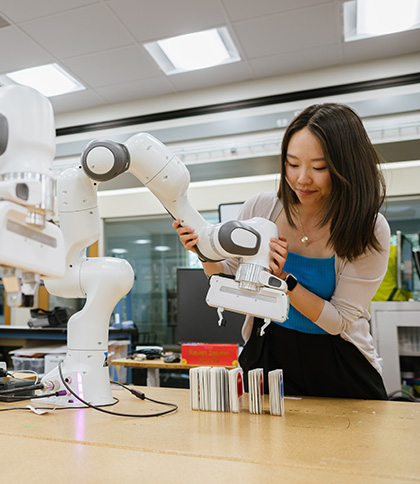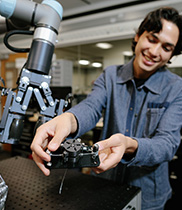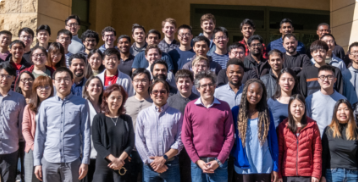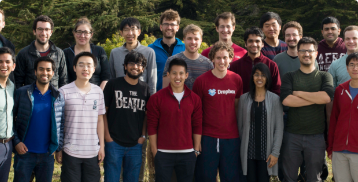Research Groups
The Stanford AI Lab is dynamic and community-oriented, providing many opportunities for research collaboration and innovation. SAIL is committed to advancing knowledge and fostering learning in an atmosphere of discovery and creativity. Our faculty conduct world class research and are recognized for developing partnerships with industry and the business community. Learn more about the diverse research groups conducting pioneering research in all areas of artificial intelligence including: Biomedicine and Health, Computational Cognitive & Neuro-science, Computational Education, Computer Vision, Empirical Machine Learning, Human-Centered and Creative AI, Natural Language Processing and Speech, Reinforcement Learning, Robotics, and Statistical or Theoretical Machine Learning.
AI faculty and research focus areas at a glance →
Stanford undergrads, prospective postdocs, and visitors interested in working in research, please follow the link to learn more about opportunities in the various AI Labs. →



Joint Faculty Labs & Groups
Chris Manning, Dan Jurafsky, Percy Liang, Chris Potts, Tatsunori Hashimoto
Fei-Fei Li, Juan Carlos Niebles, Silvio Savarese, Jiajun Wu
Emma Brunskill, John Duchi, Stefano Ermon, Emily Fox, Carlos Guestrin, Tatsu Hashimoto, Chelsea Finn, Jure Leskovec, Percy Liang, Tengyu Ma, Chris Ré, Greg Valiant
Individual Faculty Labs & Groups
The Dror Lab a highly multidisciplinary group studying the spatial organization and dynamics of biomolecules and cells in order to develop better medicines and quantitatively explain the workings of living systems.
The Bejerano Lab focuses on a fundamental question in Human Genomics: the relationship between geno(me)type and phenotype.
We research innovative computational approaches to help address the societal and environmental challenges of the 21st century.
The Geometric Computation Group, addresses a variety of algorithmic problems in modeling physical objects and phenomena, and studies computation, communication, and sensing as applied to the physical world.
Headed by Oussama Khatib Professor, Computer Science Department Director, Robotics Lab. Oussama has made fundamental contributions to robotics, control, and human motion analysis.
Our work is at the intersection of Robotics, Machine Learning and Computer Vision applied to problems in Autonomous Robotic Manipulation.
ILIAD develops algorithms for autonomous systems that safely and reliably interact with people.
A multiphysics simulation library, capable of simulating rigid & deformable bodies, compressible & incompressible fluids, coupled solids & fluids, coupled rigid & deformable solids, as well as many other natural phenomena.
The Stanford Logic Group is a multidisciplinary research group operating within the Stanford Computer Science Department.
Headed by Noah D. Goodman, Assistant Professor of Psychology, Linguistics (by courtesy), and Computer Science (by courtesy) at Stanford University.
Our research lies at intersection of neuroscience, artificial intelligence, psychology and large-scale data analysis. We seek to "reverse engineer" the algorithms of the brain, both to learn about how our minds work and to build more effective artificial intelligence systems.
The researchers at the Salisbury Robotics Lab undertake a variety of robotics projects in the development of their work. The projects in the Salisbury Robotics Lab fall under five main categories.
SISL researches advanced algorithms and analytical methods for the design of robust decision making systems.
Our mission is to significantly improve people's lives through our work in Artificial Intelligence.
We develop methodologies for the analysis, design and control of autonomous systems, with a particular emphasis on large-scale robotic networks and autonomous aerospace vehicles.
Our lab works on the foundations of the next generation of machine-learned systems, including how machines can learn from increasingly weak forms of supervision and the mathematical foundations of such techniques, as well as how machine learning is changing how we build software and hardware.
The goal of our lab is to recreate coordinated voluntary animal movements in the digital world and on robotic platforms. In particular, we focus on holistic motor behaviors that involve fusing multiple modalities of perception to produce coordinated, balanced, and precise whole-body movements to interact with the world.
The group is one of the leading centers for applied machine learning on networks. Our research focuses on modeling complex, richly labeled graphs and networks at all scales for large complex interconnected systems from information, biomedical, and social domains.
We are interested in the capability of robots and other agents to develop broadly intelligent behavior through learning and interaction. To that end, we work on robotics and machine learning.
Affiliates Program
Stanford AI Lab faculty and students enjoy chances to understand and solve the not-yet-doable pain points of industry. Get a chance to support and interact with SAIL’s brightest minds.
Learn More


